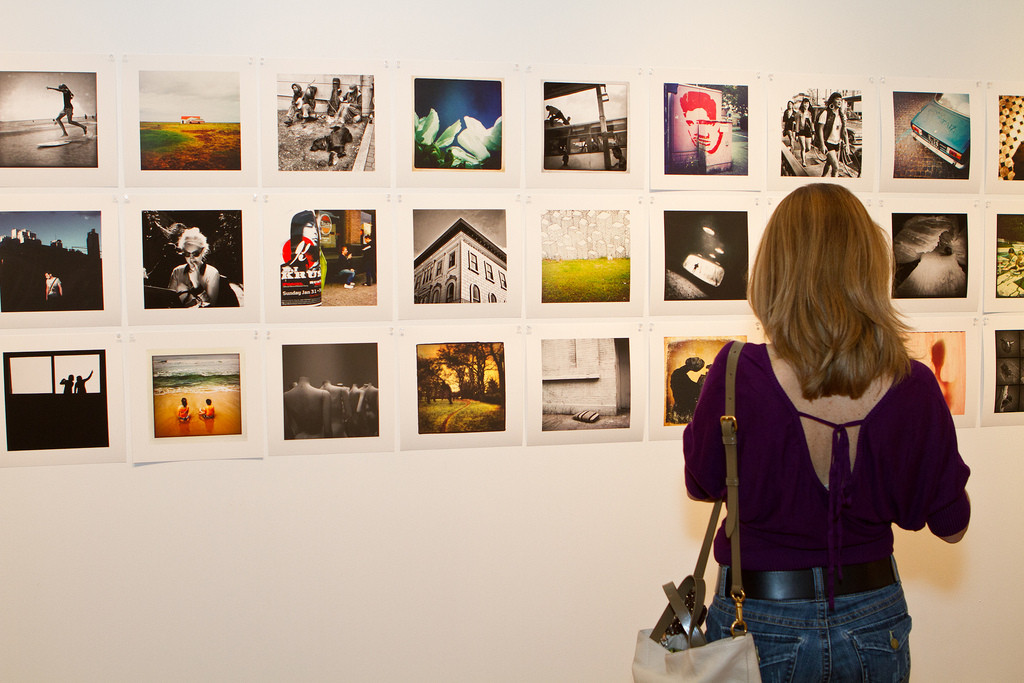April 2, 2015 | Posted in ART BUSINESS | By sockii

Photograph by BurnAway at Flickr, licensed under Creative Commons Attribution 2.0 Generic (CC BY 2.0)
Vanity Galleries Prey Upon Artists Desperate to be Shown
I am a visual artist as well as a freelance writer, and some time ago received an email which piqued my curiosity.
Entitled “Gallery Representation,” the message was an unsolicited invitation to show my work at a “well established gallery” in New York City’s “art community in the Chelsea art district.” This gallery “assistant” who contacted me commented that she had recently visited my website and felt that my “work may be well suited for representation and for inclusion in one of our many internationally publicized exhibitions.” Of course, while the gallery promised to “provide promotional services to talented artists such as” myself, “for these services we charge an annual promotional fee.”
At this point I had to laugh and a quick web search confirmed what I suspected: I was being solicited by a vanity gallery. And I also knew far better than to take the bait and do anything other than quickly file this email in my trash.
What is a Vanity Gallery?
A vanity gallery differs from a traditional art gallery in that artists have to pay a fee – either in rent of wall space, advertising and show expenses, or both – for the “privilege” of being exhibited. Sales commissions are still charged as well, but at much lower percentages than in traditional galleries which often take anywhere from 40 to 70% as their fee.
To be represented or shown by a traditional gallery, an artist usually must work very hard, sometimes for years, submitting portfolios to different galleries for which he believes his work is suited. The process can be long, frustrating and not always successful, much like a writer trying to get accepted by a traditional publishing house. As such, the idea of getting shown for a fee by a vanity gallery can be tempting to struggling artists, as typically these galleries will accept any artist to show on their walls, as long as he can pay the fee.
Therein lies the problem.
No One Takes Works Displayed in a Vanity Gallery Seriously
Art critics and savvy art consumers know to avoid vanity galleries, for the simple fact that there is no vetting control over whose work is shown and its quality. Managers of traditional art galleries typically are well educated in art history, criticism and technique, and have long-standing relationships within the art world which help them sell their artists’ work. They have relationships with local and global arts publications and press, which means exhibits in their galleries can garner published reviews and attention. In contrast, you won’t see exhibitions at a vanity gallery discussed in ARTnews!
Since a traditional gallery gets no money from an artist until a work is actually sold, they have tremendous incentive and drive to advertise their current exhibits and bring potential customers to their gallery. A vanity gallery has no such incentive as they’ve already gotten the bulk of the payment they will get from an artist upfront. A vanity gallery may be located in the “heart” of a big city’s “artistic district,” but that will make it only more likely that serious art buyers and critics already know well to avoid it, and the only potential customers you are likely to have for your work will be clueless tourists.
Vanity Galleries Versus Artist Cooperatives
A vanity gallery should not be confused with an artist cooperative, which can be a legitimate market for an artist’s work. Cooperatives are usually run by a group of artists who share in coop expenses and work together in selling their artwork. Cooperatives will not accept simply anyone who wants to pay to get in, because it is in the co-op’s best interests to have a pool of artists whose work as a whole will draw in buyers. Therefore it can be a good place to show your work if you can find acceptance at one, and are willing to share in the operations, marketing and sales of your group.
Other Alternative Exhibition and Sales Spaces

An art fair or craft show can allow independent artists to show their work to the public, without having to buy into vanity gallery space. Photo by the author, sockii.
For an artist frustrated by the traditional gallery system and looking for other ways to market her work, there are many other legitimate avenues for doing so today. However, these methods do involve the artist putting her own time into marketing and sales, not just creating art.
Many artists exhibit at art fairs and shows, which can be juried but not always (the best ones typically are.) At such fairs, artists will need to have invested in their own display set-ups and sales equipment, but they can be good venues for directly connecting with buyers and not having to pay any commissions on sales – only the fees for entering the fair.
Other artists do well selling their work online, either through a website of their own or through arts and crafts markets such as etsy. Artists should also join local art leagues and groups, which often host regular exhibits and will get their work seen by members of the community. In addition, many restaurants, coffee shops, and business offices today are interested in decorating their walls with original artwork for sale, and getting work shown there can be easier than in a traditional gallery – and at no fee to the artist unless a work sells.
In Conclusion
A vanity gallery is the artistic equivalent of a literary vanity press, and equally disdained by the traditional community of creative individuals.
Most writers are taught early on to respect Yog’s Law: “money flows to the writer” and not the other way around. Artists would do well to take this advice to heart and avoid vanity galleries at all costs. As both an artist and an individual who ran an art gallery for many years, I can assure you that showing at a vanity gallery can do more harm than good to both an artist’s reputation and bank account, and will do nothing to get an artist’s foot in the door with the professional art community.
Sources and Links for Further Information
- The Vanity Gallery: Just Avoid Them – bmoreart | Baltimore Contemporary ArtAnother artist presents his experience being approached by a vanity gallery, and why he believes they are bad news.
- Vanity Galleries: A cruel history | The Art EdgeAn artist, curator and blogger goes into some of the history of the development of vanity galleries in the 1970s.
- Secrets to Understanding the NYC Art World: Beware the Vanity Gallery – Gary Bolyer Fine ArtMore thoughts on the vanity gallery business, particularly in New York City.
- Art Gallery, Competition, Publication List Where Artists Pay to ParticipateA list of vanity galleries and other publications where artists must pay in to be featured – a good reference if you aren’t sure what kind of business you are being approached by.
This article originally was published at Yahoo! Contributors Network on January 15, 2011.
Related posts at Spacial Anomaly
Table of Contents
sockii
sockii is just your typical Jane-of-All-Trades who never has enough time in her day for all of her projects. She has written for many websites online including Squidoo, Zujava, Yahoo! Contributors Network, HubPages and Wizzley. She has been attending and vending at science fiction and media conventions for over 15 years, and for several years ran an art gallery and jewelry store in Philadelphia. Today she is happy to be living in South Jersey with her partner David and their 6 cats. Sockii is a member of several affiliate sales programs including Amazon Associates and Viglink. Products from these services may be advertised on her posts and pages to generate sales commissions.
3 Comments
Leave a Reply
*












Arthur Chappell
April 2, 2015
They sound a real rip off – I bet they’d display a child’s scribbled drawings of a matchstick mum and dad if the money was offered for them to do it – clearly wise to avoid them like the plague
sandy
April 3, 2015
Thanks for writing on this Sockii. I love your writings about being an artist. Your passion shows.
I wanted to respond to this post because it seems in every artistic endeavor offline and on, there are people who will try to take advantage of artists. I’ve seen this M. O( method of operation) in so many fields, where someone asks you to pay money with the lie that somehow you’ll become successful.
Being an artist is hard work, period. I have so much respect for artists. I usually buy from artists instead of mass manufacturers when I can.
However, I wanted to mention that here on the west coast, many doctor’s offices are giving artists a chance by working with them on joint ventures.
For free, many artists can display their works on the walls of offices.( these offices rotate out the art and need them for decoration as well as to make connections with other potential customers) I know of one dentist who not only displays the art, but he gives these wine and art evening affairs: the public(and the doctor’s clients) gets to meet the artist in person and it is good publicity for the doctor to get more clients.
If there are any artists out there, who happen to have a few pieces of art that aren’t moving, it could be worth it to search for a new business and offer to decorate their office. (Sometimes all it takes is one piece in the entrance or sitting room)
The artist can leave some cards and put a card right by the art about the piece and their contact information. At minimum, even if there isn’t a sale, many people will have exposure to your medium and your name.
Thanks for doing this piece and I look forward to more of your articles on marketing art.
I love the mix of authors you have on your site. Please keep it going. I know writing sites can be challenging, but yours is rare.
sockii
April 4, 2015
Thanks for the comment, sandy. You do bring up a good alternative which is display in professional spaces. I know of a lot of restaurants, coffee shops, and other service venues which offer artists display space for free/a percentage on any sales, and that can be a great alternative.
And yes, doctors and other offices can be a good choice as well! My partner is a podiatrist as well as a painter; his office is decorated with both of our paintings and people actually come in specifically to see the artwork sometimes. It’s helped build the office reputation and even patients have said they chose to come to his office because they figured someone with an eye for art would have an unique eye for medical care and treatment. So it can really be mutually beneficial.
I am also very grateful for your comments on S.A. overall, thank you. I am very proud of the authors we have contributing here, and have felt it important to build slowly to make sure spotlighting quality and unique voices online would be our calling card. I’ve recently upgraded our servers as well to make sure the site could grow and expand into the future and am committed to continuing this site into the future.